Jeanne de la Motte, Noblewoman and Con Artist
Nobility in pre-Revolutionary France was something of a double-edged sword. Of course it came with great privilege, and the nobles of France were permitted behaviour that was unthinkable for those of lower orders. But it also came with obligations, and one of the most notable of these was that it was unthinkable for a noble to earn their living at a trade. As such there were many people who were rich in name but poor in cash, forced to rely on the charity of the more influential to provide them with official positions and largesse. In that atmosphere of desperation many were prepared to go to great lengths to get what they felt they were owed; but few went quite as far as Jeanne de la Motte.

She was born as Jeanne de Valois-Saint-Rémy in 1756, a name that was derived directly from her noble lineage. Her father Jacques was descended from King Henry II of France (of the House of Valois) and his mistress Nicole de Savigny. Even two hundred years old and from the “wrong side of the blanket”, royal blood was more than enough to grant one the status of nobility. Their illegitimate son had been granted the title of Comte de Saint-Rémy, a title Jacques still claimed. Jeanne’s mother Marie came from far less noble stock; she was a maidservant who Jacques got pregnant. This wasn’t uncommon; what was uncommon was that Jacques insisted on marrying her despite his father’s protestations. This argument delayed their marriage until 1755, by which time they had already had two children. Jeanne (born a year later) was their first legitimate child.
Though Jacques inherited an estate from his father near Bar-sur-Aubein the northeast of France, he did not really inherit enough money to maintain it; at least not combined with his constant drunkenness and Marie’s spendthrift nature. Jeanne would later in her autobiography blame her mother for squandering the inheritance, but this may have been to cover up how little there was to squander. [1] Visitors to the estate noted how the children had to do farmyard chores, and do them barefoot. It was only thanks to the charity of the locals that they survived.
When Jeanne was young, Jacques decided to move the family to Paris where he hoped to find opportunities for a noble like himself. It was a vain hope, and he was reduced to literally begging on the street. He died in 1762, when Jeanne was only six years old. Her mother soon took on a new lover and abandoned her three surviving children into the care of a charitable local, the Marquise de Boulainvilliers.

This proved to be a fortunate occurrence for the children, as the Marquise’s wife took a liking to her new foster children. Jeanne would later describe her as her “true mother”. Luckily for them, one of the things that the nobles of France had and the rest of the country did not was a social safety net. Once Madame de Boulainvilliers was able to prove their royal lineage they were entitled to a small annual stipend from the crown; enough for Jeanne’s brother Jacques to go to a military academy and for Jeanne and her sister Marie-Anne to attend a boarding school. When they completed their schooling they were sent into a convent, but Jeanne turned out not to have “the monastic temperament”. In 1776 she ran away from the convent (taking her little sister with her) and returned back to her childhood home in Bar-sur-Aube.
There she was taken in by the Surmont family, landed gentry with their own distant link to the nobility. After four years in their household, she married a nephew of the household by the name of Nicolas de la Motte, an officer in the gendarmerie (a local militia that was a precursor to the police). It was a whirlwind romance, necessitated by the fact that Jeanne was heavily pregnant when she was married.
She herself gives very little details about how she and Nicolas came to get married; scandalous later rumours implied that she fell pregnant from a lover she could not marry and swiftly ensnared Nicholas as a marriageable prospect and convinced him the children were his. Why could she not marry her lover? Because, said the rumours, the father was actually the man who officiated at her wedding: the Bishop of Langres. Whether this was true or not is impossible to say; she gave birth to twins shortly after the wedding but they only survived a few days. Infant mortality like that was a cruel fact of life back in those days.

Nicolas de la Motte was, according to Jacques Claude Beugnot [2], ““homely but a man of splendid physique”. Jeanne, on the other hand, was a slim brunette with clear blue eyes and a “winning smile”. She was chronically unfaithful, of course, as was he. This was only to be accepted. However her affair with his commanding officer the Marquis d’Autichamps was a bit too blatant and caused enough of a scandal that Nicolas had to resign from the gendarmerie. His salary hadn’t really been enough to keep the pair in the standard they preferred anyway, which may have been why Jeanne had been dallying with his superior. Now deprived of even that, Jeanne and Nicolas were forced to take the same path as many other impoverished nobles, including her mother: head to Paris, and throw themselves on the mercy of the Royal Court.
Over the next few years Jeanne did her best to inveigle her way into the graces of the powers that were at the court, with varying degrees of success. A strategically timed fainting fit saw her becoming acquainted with “Madame Élisabeth”, the teenage sister of King Louis XVI. She also got into the good graces of the King’s sister-in-law Maria Theresa (the comtesse d’Artois) and then rapidly back out of them when the comtesse thought that Jeanne was getting a bit too friendly with her husband the comte.
Around this time Jeanne began to claim for herself the title of Comtesse de la Motte, thought she had no entitlement to such a title. She began an affair with another court hanger-on, a childhood friend of her husband called Louis Marc Antoine Rétaux de Villette. Rétaux was also a child of minor nobility, who now supported himself primarily through the Parisian sex trade. He was a handsome and personable young man, something which he used both to sell himself to bored noble ladies and to entice girls into working in the brothels of the capital. Jeanne made him her “personal secretary”. And then in 1783 her old guardian, Madame de Boulainvilliers, made the fateful decision to introduce Jeanne to Cardinal Louis de Rohan.
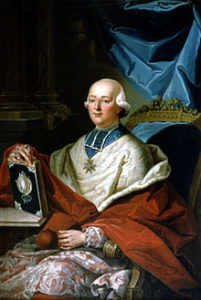
Louis de Rohan was from one of the most noble French families, claiming descent from the kings who had ruled Brittany before the unification of France. He was one of the “nobles of the Church”, heir to a bishopric which had been in his family’s control for generations and which came with a seat as Prince-Elector in the Holy Roman Empire. Unfortunately for him he was currently on the outs with the royal family, as he had been one of the more vocal opponents of the Austrian alliance which had been sealed with the marriage of Louis XVI and Marie-Antoinette. Still, he was rich, powerful and utterly unconcerned with his priestly vows of chastity. In other words, he was exactly the type of patron Jeanne was after. She immediately set herself to becoming his mistress, and succeeded.
Jeanne’s connection with de Rohan paid some immediate dividends for the de la Mottes, with Nicolas receiving a post in the bodyguard of the Comte d’Artois as a result of the Cardinal’s influence. However it wasn’t enough to satisfy Jeanne. So she decided to turn to fraud. Among his other gifts, her “personal secretary” Rétaux was a gifted forger, and he managed to perfect an imitation of the Queen’s handwriting that Jeanne decided to take advantage of. She convinced the Cardinal that her friendship with Marie-Antoinette was far deeper than it actually was, and that their lack of public connection was because of Jeanne’s post as “fixer” for her Majesty. Then she gave him letters (forged by Rétaux) where the Queen asked the Cardinal for loans to supplement the allowance she was given by the king. She managed to get around a hundred and twenty thousand francs out of him, a huge sum for the time. Then she heard about Charles Auguste Boehmer and his diamond necklace, and immediately saw the opportunity for an even bigger score.

Boehmer and Bassenge, the most exclusive jewelers in Paris [3], had been commissioned by King Louis XV to create a diamond necklace for his mistress Madame du Barry. Since this was possibly the most opulent necklace ever made they had gone deeply into debt in order to buy the stones for the necklace. Then disaster had struck when Louis XV died before the necklace was complete. The new king had no intention of honouring his father’s deal, and of course there was no way Boehmer and Bassenge could enforce the original contract. They tried to sell the necklace, but soon realised that only the royal family could afford it. Marie-Antoinette though made it clear that she had no intention of purchasing anything ever intended for a royal mistress. Boehmer and Bassenge were facing ruin, and they were desperate. Desperate enough to reach out to anyone who might have the Queen’s ear, including the Comtesse de la Motte. Jeanne decided to take advantage of that desperation.
First, Jeanne spread a rumour (meant for the Cardinal and Boehmer’s ears) that Marie-Antoinette actually desperately wanted the necklace, but was afraid of her husband’s disapproval of the extravagance if she bought it. This rumour would turn out to have far more effect than Jeanne had planned. Next, she had Rétaux forge a letter from the Queen to the Cardinal about the necklace. By now the tone of these letters had become decidedly heated, and the Cardinal was thoroughly convinced that the Queen was in love with him. He begged Jeanne to arrange a secret meeting, and she decided that this was what she needed to fully bait this trap. Cardinal de Rohan was going to meet the Queen – or so he thought.
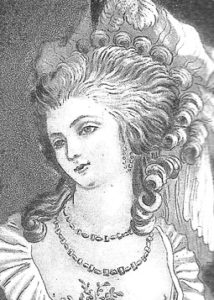
Jeanne’s husband Nicolas was acquainted with a prostitute named Marie-Nicole Leguay d’Oliva, who had a strong resemblance to Marie-Antoinette. (Nicole would later claim that she had not known Nicolas beforehand and that she had been told she was being recruited to take part in a practical joke on the Cardinal. How true this version is cannot be determined.) Nicole was dressed in a white gown and taken into the gardens of the Palace at Versailles, where she was approached by the Cardinal. She handed him a white rose, and said “You know what this means.” (In the “language of flowers” popular in European courts at the time, a white rose meant “I am worthy of your affections”.) She also had a letter instructing him to buy the necklace, but she forgot to hand it over. It didn’t matter – the Cardinal was on the hook.
Boehmer and Bassenge were delighted when the Cardinal opened negotiations to purchase the necklace on behalf of the Queen. A price was agreed of one million six hundred thousand livres (around eleven million euros in modern money). This was to be paid in installments, and in January of 1785 the Cardinal gave them a note for the first installment. He took the necklace back to Jeanne de la Motte’s house, where a “valet of the Queen” came and took it away. Of course, the “valet” was nothing but. Instead Nicolas took the necklace to London, where he began to break it up and sell off the stones slowly so as not to flood the market. And that was how they pulled off the biggest con of the 18th century.
Like most great crime capers though, the problem came in the follow-through. While the Cardinal had covered the down payment on the necklace, he had naturally assumed that the Queen herself would be arranging the later payments. So that was what he had agreed with Boehmer and Bassenge. When the money didn’t appear six months later as promised, then they went looking for it. They first went to see the Cardinal, but he (prompted by more forged letters) gave them the runaround. They had previously written a letter to the Queen thanking her for purchasing the necklace and noting that they had not seen her out wearing it yet. The Queen had no idea what the letter was talking about, and unfortunately for her she decided to ignore it. To try to find out what was going on Boehmer approached Henriette Campan, one of Marie-Antoinette’s ladies-in-waiting. She was alarmed by this story, and took it to the Queen. She summoned the jewelers to seek an explanation, and this was where things began to come to light. They gave her a written record of their side of the story, and it put the Cardinal de Rohan directly in the frame.
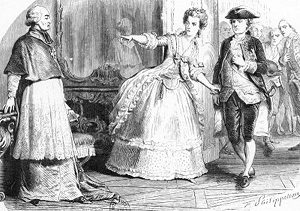
Jeanne had expected that the jewelers would approach the Cardinal, since he was listed as the guarantor of the debt. If they had done so, then he might have simply paid the rest of the balance in order to keep things quiet. It’s likely that’s what the letters he received were leading up to. Boehmer and Bassenge going to the Queen put an end to that. Things came to head on the 15th August. It was the feast day of the Assumption of Mary, and the Cardinal de Rohan was due to officiate at a mass attended by the royal family. Instead he was taken before the King and Queen and asked to explain himself. At first he was confused, and explained that he had been acting on behalf of the Queen. He sent for the letter where she had asked him to purchase the necklace (and instructed his servant to destroy the rest of the correspondence, to avoid complications). When the letter was produced, the King went into a rage. It was signed “Marie-Antoinette de France”, but as anyone in the court should have known the Royals signed their letters with their first names only. This was a clear forgery, and one which a “prince of the blood” like the Cardinal should have recognised. He was sent off to the Bastille, and the investigation began.
It didn’t take the investigators long to pick up on Jeanne’s involvement, and she was arrested three days after the Cardinal. (Enough time for her to destroy her side of the correspondence.) Rétaux was also swept up pretty quickly. Nicole took a little longer, since she and her new boyfriend (later her husband) had moved to Brussels, but she was also captured and brought back to Paris. One other person of interest who was arrested is someone who hasn’t been mentioned yet – Count Cagliostro, a friend of the Cardinal de Rohan. Cagliostro (real name Giuseppe Balsamo) was an occultist who many of the French court consulted, and he had “confirmed” for the Cardinal through mystical means that the correspondence with the Queen was genuine. Since he had been previously visited by Jeanne and his friends, the Cardinal (now clutching at straws) doubtless thought that he may have been in on it. The Count was eventually exonerated, though he gave good entertainment at the trial by (among other things) admitting to being guilty of murdering the Roman general Pompey.
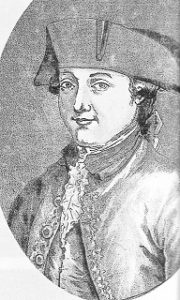
Because there was a trial, of course. (Pope Pius VI officially objected to the trial as he said that a churchman could only be tried by the church, but he was ignored.) Unusually it was a public one; since the reputation of the Queen had been impugned then the King decided that this should be all resolved out in public. The trial took place in January of 1786 and it was a huge popular sensation. All of the principles gave their testimony, with Jeanne still insisting that she had been following the Queen’s orders. All of the others gave their version of events, but it was Rétaux de Villette who was the star witness for the prosecution. He made a deal and gave a full account of what had happened, one which made it clear exactly what had been going on and that the Queen herself had nothing to do with it. As a result Nicole was released as an innocent dupe, while Rétaux himself was simply sentenced to exile as part of his deal. The Cardinal was originally ordered to publicly apologise for presuming that the Queen would meet him in the gardens at midnight, but this was eventually voted down and he was acquitted. (The implication that this meant the Queen would have met him in the gardens at midnight was lost on nobody.) In the end all the blame was placed on the de la Mottes.
That was the official verdict, at least, and it’s one that most historians agree with. The public, though, came to a very different conclusion. The rumour that Jeanne had planted that the Queen did actually want the necklace was resurrected, and the general opinion was that the Cardinal had been used to satisfy the Queen’s extravagance and then hung out to dry in order to punish him for opposing the royal marriage. This was backed up by the fact that, though he was exonerated of wrongdoing, the Cardinal was still exiled from Paris. The result was that the Queen (already deeply unpopular because she was Austrian and the French people had a deeply held prejudice against them) became utterly vilified. The blow this caused to the prestige of the monarchy was a large part of the shift in mentality which would lead to the French Revolution.

At the conclusion of the trial Nicolas de la Motte, who was still hiding out in London, was sentenced in absentia to be flogged, branded and then to serve life on the galleys. [4] Jeanne de la Motte was sentenced to be publicly whipped and branded as a thief (with the letter “V” for voleuse) before being imprisoned for life. The sentence took place in June of 1786, around a month before her thirtieth birthday. The public audience were largely sympathetic to Jeanne, who the believed was simply a pawn being sacrificed by the “evil Queen”. Jeanne herself only found out about her sentence the morning it was to be carried out and fought every inch of the way as she was stripped, flogged and then branded with hot irons. In fact she struggled so much that the executioner botched the branding; rather than being branded on each shoulder instead one ended up on her chest. This further incensed the crowd and she was swiftly bundled off to the Salpêtrière, a prison for “dissolute women”.
Jeanne was in the prison, which held thirty-six women in tiny cells, for only one year. Then, somehow, she managed to escape. Exactly how is impossible to say. Her own version (given in her memoirs) involved her being contacted by someone from outside the prison who offered to help her escape. They provided materials where she sketched the key of her cell, and then they used the sketch to give her a duplicate of it. They also provided her with a disguise, which she used to escape from the prison undetected. Once out she was met by a confederate of her husband, who smuggled her across the ocean to England. The story is full of holes, and it’s likely that she created it to protect whoever it was that really helped her escape. The most likely culprits were proto-Revolutionaries who wanted her to continue to cause problems for the royal family. And Jeanne was happy to oblige.
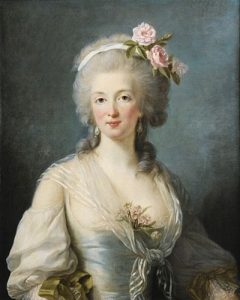
In 1789, from the safety of London, Jeanne released her memoirs: Memoires Justificatifs de La Comtesse de Valois de La Motte. (She almost certainly didn’t write it herself, of course. One Royalist later wrote that they were “composed for her by a French writer, a former actor, whom she paid for his work with her mercenary favours.”) This “memoir” was very much designed to portray Jeanne as the heroine and the Queen as a villain, continuing the line she had maintained in her trial that she had been Marie-Antoinette’s “fixer” and was being thrown to the wolves. The book was banned in France, of course, but people still read it. It was also translated into English where it was popular for confirming most of the prejudices English people had about the French.
The memoirs also brought in some cash, which Jeanne needed as Nicolas had squandered most of the proceeds from the sale of the necklace. Their marriage, which had survived multiple infidelities in the Parisian court, did not survive their exile to London. After the fall of the Bastille and the overthrow of the French government made him free of any risk of serving his punishment Nicolas returned to Paris. He lived there for the next forty years, receiving a pension from the de Rohan family in exchange for his not publishing his memoirs. Jeanne stayed in London, living in a small two-room apartment.
She was, like most such minor celebrities, subject to a stream of visitors. One of the more notable was a servant of Marie-Antoinette in exile, who asked her (in exchange for a financial consideration) to confess to having forged the Queen’s signature on the letter assenting to the purchase of the necklace. At the time Marie Antoinette was the prisoner of the Revolutionaries, and he hoped that this would help to win her some clemency. Jeanne responded by showing him the burn mark on her chest from the branding and the scars on her legs from the whipping, and then throwing him out.

Jeanne died in August of 1791, under somewhat dubious circumstances that lead to rumours of her being murdered by Royalist sympathisers. The official verdict was that a bailiff came to her apartment to demand payment of a bill. She gave him a bottle of wine, then slipped out of the room and locked him in. He broke out and cornered her in a room at the back of the house, and in an attempt to escape she jumped from a second story window. She hoped that a tree would break her fall; instead it broke her leg and sent her tumbling head first to the ground where the impact knocked one of her eyes out. She died from her injuries a few days later, at the age of thirty-five. A year later, in July of 1792, the Revolutionary Court of Paris quashed her conviction; part of their campaign to blacken the name of the monarchs. The following year Marie-Antoinette was executed.
In histories of the French Revolution the “Affair of the Diamond Necklace” is often pointed to both as a sign of the falling prestige of the royal family and as one of the factors that led directly to the shift in public perception of the monarchy that made the Revolution possible. As a result it (and Jeanne) have been the subject of much interest over the last two centuries. Johann Wolfgang von Goethe and Alexandre Dumas both wrote novels focusing on Cagliostro’s involvement in the affair; and Orson Welles later made a movie based on the Dumas novel.
Of course, there have also been countless French novels and movies about the whole scandal. The diamond necklace is a constant in stories of the court of Louis XVI (including 1970s manga The Rose of Versailles); and it was the subject of a Hollywood historical drama in 2001. With its heady mixture of sex, criminality and court intrigue; it’s not surprising that the story of Jeanne de la Motte’s great diamond heist draws interest over two hundred years after her death.
Images via wikimedia.
[1] Jeanne’s autobiography attempts to present her as always the heroine and the victim of circumstance, even though that definitely involves stretching the facts on some occasions. Combine that with the contrasting desire of others to paint her as a villain and the poor records we have of the time (due to the disruption of the Revolution in the 1790s); and the result is once again a biography that has to be taken with a few grains of salt.
[2] Beugnot was the son of one of the nobles who helped Jeanne when she returned to Bar-sur-Aube. He later went on to have a long and successful career in politics, adroitly navigating the changing currents of Revolution, Empire and Restoration. As a teenager he was besotted with Jeanne, and his writings are an important source for this part of her life.
[3] Boehmer et Bassenge are still in existence and are still among the great jewelers of Paris.
[4] Originally this sentence would have meant a life of slavery as a galley-rower. Rowed galleys were no longer in use at this time, but the sentence was still used to mean permanent imprisonment on the hulk ships used as prisons.
